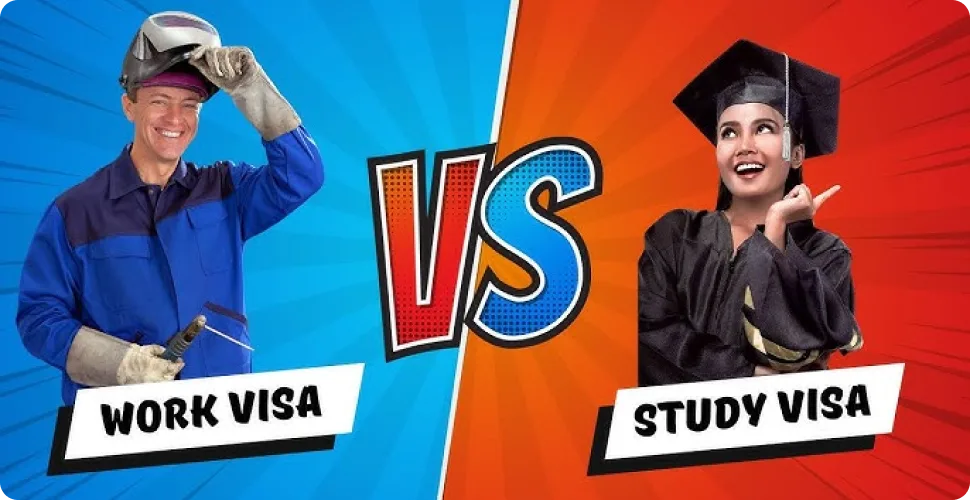When it comes to moving abroad for studies or work, one of the first things you’ll hear about are visas. Among the most common are student visas and work visas. While both allow you to stay in another country, the purpose, eligibility, and benefits are very different. If you’re confused between the two, this guide will clear things up. Let’s break down the student visa vs work visa debate in detail.
What is a Student Visa?
A student visa is a temporary visa granted to individuals who want to pursue education in a foreign country. It allows international students to study at approved universities, colleges, or schools.
Most student visas come with specific conditions like:
- You must be enrolled in a recognized institution.
- You need to show proof of financial support for tuition and living expenses.
- Some countries allow part-time work with limited hours.
The main purpose of this visa is education, not employment.
What is a Work Visa?
A work visa is designed for people who want to work in a foreign country. It can be temporary or permanent depending on the type of job and the country’s immigration policy.
Work visas often require:
- A job offer from an employer in the destination country.
- Relevant qualifications or work experience.
- Sometimes labor market tests to prove no local worker is available for the role.
Unlike a student visa, the focus here is on employment and contribution to the country’s workforce.
Student Visa vs Work Visa: The Key Differences
Understanding the difference between a student visa and a work visa is crucial before deciding which path suits your goals.
1. Purpose
- Student Visa: Primarily for education, though some part-time work may be allowed.
- Work Visa: Meant for full-time employment and building a career.
2. Eligibility Requirements
- Student Visa: Requires admission in an educational institution, proof of funds, and sometimes language proficiency (IELTS, TOEFL).
- Work Visa: Requires a job offer, relevant skills, and in some cases, sponsorship from an employer.
3. Validity
- Student Visa: Usually valid for the duration of the course.
- Work Visa: Can vary from a few months to several years, sometimes leading to permanent residency.
4. Work Rights
- Student Visa: Limited work hours (e.g., 20 hours per week during classes).
- Work Visa: Full work rights, often with the same benefits as local employees.
5. Family Sponsorship
- Student Visa: Some countries allow spouses and children, but with restricted rights.
- Work Visa: More favorable for bringing dependents, with better work or study opportunities for family members.
Benefits of a Student Visa
- Access to world-class education and training.
- Opportunity to experience new cultures and lifestyles.
- Limited work rights to gain part-time experience.
- Pathway to post-study work visas in many countries.
Benefits of a Work Visa
- Ability to earn a stable income while living abroad.
- Gaining international work experience.
- Eligibility for permanent residency in some cases.
- Better opportunities to bring and support family members.
Which One Should You Choose?
The decision between a student visa and work visa depends on your personal goals.
- If your primary aim is education and career growth through study, a student visa is the right choice. It can also lead to post-study work opportunities.
- If you’re already qualified and looking for overseas job opportunities, a work visa is a better option.
In many cases, students transition from a student visa to a work visa after graduation, making it a step-by-step pathway.
Popular Countries Offering Student and Work Visas
- Australia: Offers subclass 500 (student visa) and various skilled work visas.
- USA: F-1 student visa, H-1B work visa.
- Canada: Study Permit for students and Work Permit/Express Entry for workers.
- UK: Tier 4 student visa and Skilled Worker visa.
Each country has its own rules, so always check the specific immigration guidelines before applying.
Common Challenges with Student Visa vs Work Visa
- Student Visa Challenges: Proving financial capacity, adapting to cultural differences, and strict work limitations.
- Work Visa Challenges: Finding an employer sponsor, meeting skill shortages, and sometimes long processing times.
Final Thoughts
The debate of student visa vs work visa is not about which one is better—it’s about which one aligns with your current goals. Students who wish to build knowledge and skills often start with a student visa, while professionals with work experience may directly apply for a work visa. Either way, both options open doors to global opportunities.
FAQs
Q1. Can I work full-time on a student visa?
No, most countries limit student visa holders to part-time work during semesters and full-time only during breaks.
Q2. Can a work visa lead to permanent residency?
Yes, in many countries a work visa can be a direct pathway to permanent residency.
Q3. Can I switch from a student visa to a work visa?
Yes, many students apply for a work visa after graduation, provided they meet job and skill requirements.
Q4. Which visa is easier to get, student visa or work visa?
A student visa is generally easier if you have admission and funds. Work visas are more competitive due to employer sponsorship requirements.
Q5. Can I bring my family on a student visa or work visa?
Yes, both visas allow family sponsorship, but work visas usually give dependents more rights to work or study.




